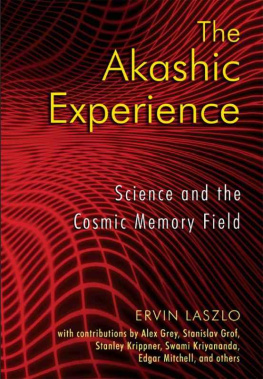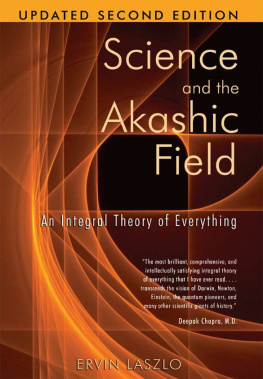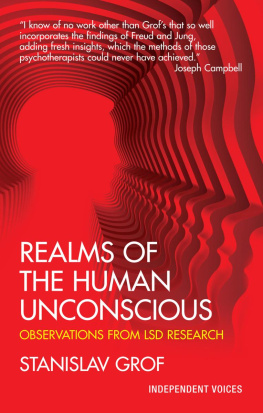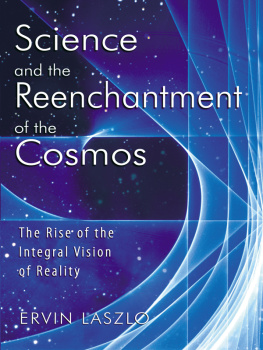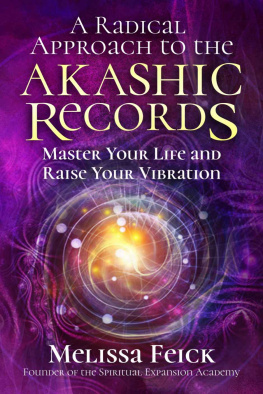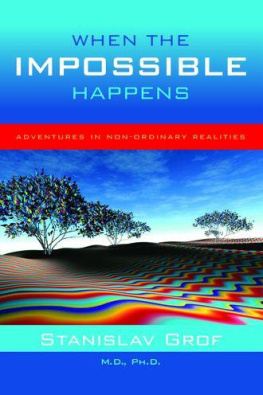
Table of Contents

C. J. Martes
Swami Kriyananda (J. Donald Walters)
David Loye
Stanley Krippner
Jude Currivan
Guido Ferrari
Christopher Bache
Maria Sgi
William Gladstone
Oliver Markley
Raffi Cavoukian (Raffi)
Alex Grey
Eric Pearl
Masami Saionji
Marilyn Mandala Schlitz
Pim van Lommel
Stanislav Grof
Fr. Franois Brune
Edgar Mitchell
Larry Dossey

I N T R O D U C T I O N
The Akashic Experience
WHAT IT IS AND WHAT IT MEANS

WHAT IS AN AKASHIC EXPERIENCE?
This volume is dedicated to the exploration of a fundamental yet in the modern world widely neglected aspect of life and consciousness: the Akashic experience. It contains twenty firsthand reports on this experience by serious, widely known, and highly credible individuals. The accounts make fascinating reading. Before getting down to reading them, however, readers may ask, just what is an Akashic experience? The question is to the point and merits a prompt answer.
To give a basic definition of the Akashic experienceunlike giving a scientific explanation of itis not difficult. An Akashic experience is a real, lived experience that conveys a thought, an image, or an intuition that was not, and very likely could not have been, transmitted by our senses either at the time it happened or at anytime beforehandat least not in our current lifetime. In a popular, though overused and misused formulation, the Akashic experience is a lived experience in the extra or non-sensory mode.
The Akashic experience comes in many sizes, forms, and flavors, to all kinds of people, and all its varieties convey information on the real worldthe world beyond the brain and the body. The experience ranges from artistic visualizations and creative insights to nonlocal healings, near-death experiences, after-death communications, and personal past life recollections. Notwithstanding the great variety in which it occurs, the Akashic experience has strikingly uniform features. Whatever else it may contain, the Akashic experience conveys the sense that the experiencing subject is not separate from the objects of his or her experiencethe sense that I, the experiencing subject, am linked in subtle but real ways to other people and to nature. In deeper experiences of this kind there is a sense that the cosmos and I are one.
In its many variations, the kind of experience reported in this book suggests that it comes from somewhere beyond our brain and body, and that the information on which it is based is conserved somewhere beyond our brain and body. The Akashic experience gives clear testimony that we are connected to an information and memory field objectively present in nature. In my book Science and the Akashic Field, I have given a detailed rationale for naming this astonishing, but in traditional cultures long recognized, reality the Akashic field. Here, a preliminary look at cutting-edge science and its rediscovery of this remarkable facet of ancient Indian philosophy will help to explain this name and the nature of the experience to which it refers.
SCIENCE AND THE AKASHIC EXPERIENCE
Science is currently undergoing a fundamental paradigm shift. The currently dominant paradigm of separate material things connected by mechanistic relations of cause and effect is failing; there are ever more things and processes it cannot account for. Classical sciences conception of the universe has turned out to be flawed. The primary stuff of the universe is energy and not matter, and space is neither empty nor passiveits filled with virtual energies and information. The universe is an evolving integral system, staggeringly coherent and interconnected.
Leading scientists are discovering a deeper dimension of the universe, a dimension variously called physical space-time, hyperspace, holofield, implicate order, or nuether. This dimension is associated with the mysterious virtual-energy sea misleadingly called quantum vacuum (misleading because this deep dimension is not part of the quantum world but underlies it; and its not a vacuum but a plenum: its filled, not empty, space). The unified vacuumeffectively a cosmic plenumcarries the famous zero-point field (ZPF), and grand-unified and super-grand-unified theories ascribe all the fields and forces of nature to it. It is the unified field sought by Einstein near the end of his life.
As scientists now realize, the unified vacuumnow widely known as the unified fieldis the originating ground as well as the ultimate destination of all the things that arise and evolve in space and time. In the fiery cosmic birthing of the big bang, pairs of particles and antiparticles sprang from the unified field, and they continue to spring forth in particle accelerators and stellar processes and wherever energies of an extremely high level are produced. In the final collapse of black holes the degenerate remnants of surviving particles die back into this fieldperhaps to reemerge again as pairs of particles and antiparticles in the birth of a new universe.
The unified field may have an even more fundamental role. Our universe is not the only universe there is; cosmologists speak of multiple universes arising in a vaster and possibly infinite meta-universe or metaverse. The unified field can be assumed to persist even as universes emerge and die backits the stage on which the repeating drama of cosmic birthing and rebirthing takes place. Its the cradle and the grave of all universes, our universe included.
In regard to its cosmic role and encompassing reality, the unified field is a rediscovery of the ancient concept of Akasha. In ancient India the Sanskrit word Akasha meant cosmic sky, similar to our concept of space. But Akasha referred not only to space in the modern sense but also and above all to the higher spheres of life and existence. The Hindu seers believed that all things arise from, and re-descend into, the cosmic source they called Akasha. Akasha was seen as the first and most fundamental of the five elementsthe others were vata (air), agni (fire), ap (water), and prithivi (earth). Akasha was said to embrace the properties of all five elements. And it was believed to conserve the traces of everything that ever happened in space and in time. Akasha is the enduring memory of the cosmos: it is the Akashic Record.
In his classic Raja Yoga, Swami Vivekananda described the ancient concept of Akasha like this:
The whole universe is composed of two materials, one of which they call Akasha [the other is Prana, an energizing force]. Akasha is the omnipresent, all-penetrating existence. Everything that has form, everything that is the result of combination, is evolved out of this Akasha. It is the Akasha that becomes the air, that becomes the liquids, that becomes the solids; it is the Akasha that becomes the sun, the earth, the moon, the stars, the comets; it is the Akasha that becomes the human body, the animal body, the plants, every form that we see, everything that can be sensed, everything that exists....
At the beginning of creation there is only this Akasha. At the end of the cycle the solid, the liquids, and the gases all melt into the Akasha again, and the next creation similarly proceeds out of this Akasha.
Next page
